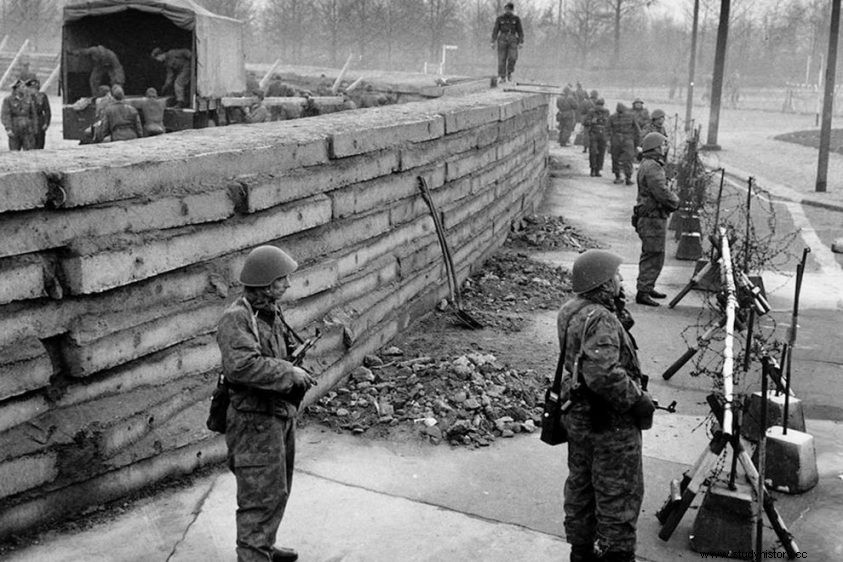
When and why was the Berlin Wall built?
How tall was it, where is it, how many people have tried to overcome it and how many have lost their lives trying to reach the other side?
How many worked on the construction of the wall, and how many worked on the surveillance of the wall?
Are we really sure this data is of any importance?
After all, this information tells us only that that wall was just a border wall, well fortified, and that divided a city in two, but we already knew this, it was implied in its name, "Berlin wall".
What this information alone does not tell us is what that wall really was, what it represented for those who lived in that city, and for those who lived outside that city. It does not tell us what that wall represented for those who lived on one side or the other of the death strip, on the right side or the wrong side of the wall ... and which was the right or wrong side, maybe we will never know, and in reality in historical terms, we don't even care to know.
One thing is certain, thirty years ago, on November 30, 1989, that wall was knocked down and its fall was perhaps the most important episode of the twentieth century, perhaps second only to the end of the Second World War, or perhaps it has represented the true end of the Second World War.
But anyway, if numbers, raw and raw, are what you want, you are served.
The wall was 3.6 meters high, it was built in several laps between 1961 and 1975, to be more precise, a first wall was built on the border between East and West Berlin in 1961, then renovated in 1965. More inside , about ten meters from the 1961 wall, a second wall was built in 1962, then renovated in 1965.
The two together delineated the "eastern" and "western" border of the "death strip" a corridor less than ten meters wide that extended around West Berlin for over 150km. Its name does not leave much room for the imagination, anyone who set foot there, without authorization, was going to meet death.
The wall housed about 13 passages, nine of which connected West Berlin to East Berlin, the remaining four connected West Berlin to the German Democratic Republic (GDR).
The gates, as well as the entire wall, were manned and guarded on sight, twenty-four hours a day, seven days a week, by about a thousand border guards and three hundred canine units, assisted by more than six hundred snipers, perennially on guard over the more than three hundred towers on guard. And in order not to miss anything, the "death Strip" was permanently illuminated, surrounded by several kilometers of barbed wire and housed an anti-tank moat.
The wall was built to prevent the German population of the GDR from reaching West Berlin and from there fleeing to the FRG (German Federal Republic), and it must be said that it fulfilled its task very well, since between 1961, the year of the construction of the wall and 1989, the year of the fall of the wall, only 5,000 people managed to escape, many of them between 13 and 15 August 1961, when the wall was still little more than a barbed wire fence. Unfortunately, it should be noted that, in an attempt to escape, about 600 lost their lives between '61 and '89.
It should be noted that, in the period immediately preceding the construction of the wall, between 1958 and 1961, about 2.5 million people left the GDR, taking advantage of the air bridge that connected West Berlin to the FRG and the Western world.
We do not know the total cost of the wall, but we do know that the last modernization, in 1975, cost the GDR government about 16 million marks, the equivalent of about € 50 million in 2015.
If these data are not enough for you, I suggest you recover the video associated with this post, in which in addition to the raw data, I also explain what led to certain choices and what was the international climate when certain choices were made.
I also recommend reading the anthology " Heaven cannot be divided. Stories from the Berlin Wall ”Edited by Gianluca Falanga https://amzn.to/2BDCLFe and the essays, Ulrich Mählert, La DDR. A short history 1949-1989 | https://amzn.to/2oZ7iuB, Gianluca Falanga, The ministry of paranoia. History of the Stasi | https://amzn.to/2WaToS9
Anna Funder, Once upon a time there was the GDR | https://amzn.to/2oeIazs, Garton Ash, Timothy, The dossier | https://amzn.to/2JjkYaI
